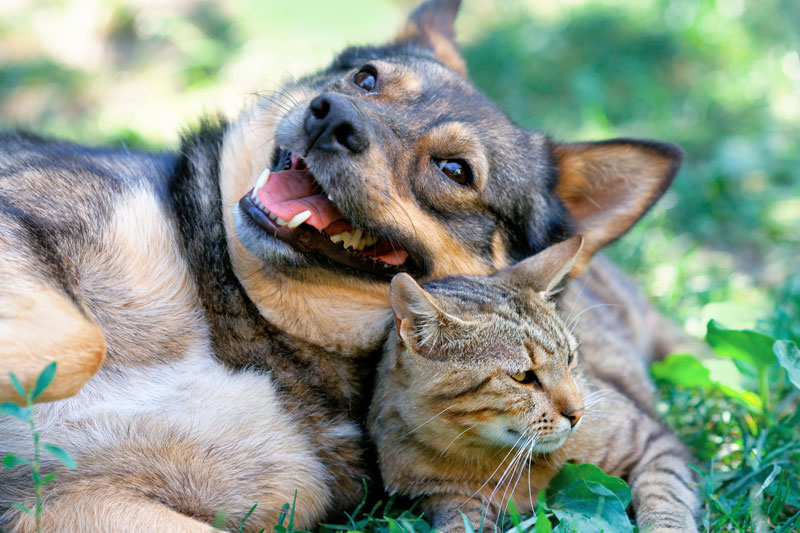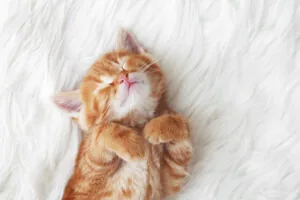Pheromones for Our Pets

Pets, like humans, can get stressed out. Things like new homes, visitors, thunderstorms, or separation anxiety can be major stressors for cats and dogs alike. Stressors like this can trigger destructive or bothersome behaviors like urinating in the house, excessive vocalizing, trembling, panting, or chewing. There are a number of ways to address anxiety in pets, and most vets will recommend a daily oral prescription medication to manage anxiety. Pet owners may not prefer to use oral prescription medication, and turn to alternatives like pheromone calming products.
What Are Calming Pheromones for Cats and Dogs?
Pheromones are odorless and colorless chemical signals that are species-specific. This means products created for use with cats will not work on dogs and vice versa. Each type of pheromone sends a specific comforting message to the pet, that you are safe. Calming dog and cat pheromones come in a number of formats, including plug-in diffusers, collars, sprays and wet wipes.
Using Pheromones for Dogs vs. Pheromones for Cats
Dogs and cats can benefit from the use of calming pheromones in different ways. For example, calming pheromones can help dogs who have a difficult time with loud noises, especially in the case of thunderstorms and fireworks, where noises come together with flashes and bursts of lights that are frightening to dogs. Some dogs also are often confused and upset by being left at home for long periods while their family is at school and work, causing separation anxiety or separation distress. Pheromones help the dog feel safe and can prevent unwanted behaviors like whining, crying, pacing and being destructive when the pet is alone in the house.
In cats, calming pheromones are also useful for making them feel safe and secure, either when alone or in the presence of other cats. Conflict between cats is very concerning because once friction has escalated, those relationships are not easily repaired. Using pheromones when adopting an additional cat may help the relationship begin well.
Dogs
Dog-appeasing pheromone products are synthetic versions of a chemical compound naturally secreted by lactating mother dogs during nursing. These are odorless but are detected by a dog’s vomeronasal organ, which is connected not only to the olfactory system (your dog’s sense of smell), but also to the amygdala and hypothalamus — important parts of a dog’s brain that affect behavior and nervous system reactions. This organ allows dogs to taste and smell pheromones. You might notice a dog make a funny face after smelling something, almost like they are “tasting” the smell. This is called the flehmen response, and while it isn’t seen as often in dogs as it is in cats, horses, or other animals, when dogs are processing the smell you might see them flicking their tongues or smacking their mouth to better gather all the pheromone’s information. When a dog smells the dog-appeasing pheromones that they have associated with the safety and comfort of their mother and littermates, their autonomic nervous system (which is responsible for the reactions of fight, flight, rest, and relaxation) responds in a positive way, helping them relax and stay calm. For this reason, pheromones have been widely suggested for helping dogs during transitional periods or with anxieties and phobias.
How to Use Pheromones for Your Dog
Follow these tips to get the most benefits from using dog-appeasing pheromones with your dog:
- It’s recommended by manufacturers to expose your dog to pheromones for a longer period of time in order to see noticeable results. Don’t plug in a diffuser and expect instant results — leave it plugged in (or the collar on) for at least 2 weeks, if not longer.
- Use dog-appeasing pheromones in the following situations to help set your dog up for success and prevent anxiety or fear from developing:
- When you first bring a new puppy home
- When bringing home an adopted dog
- During puppy play dates and dog training classes
- During thunderstorm season
- Before and during veterinary visits
- When guests or visitors come to your home
- During car rides or other travel that might cause your dog anxiety
- Combine pheromone therapy with behavior modification and training, focusing on counterconditioning and desensitization.
Cats
If you have one or more cats that experience intense bouts of anxiety, you may have taken them to the vet to discuss ways to alleviate that stress. After all, stressed cats are at higher risk for digestive problems, lower immunity and other health issues. They can also be a nightmare to live with.
Some signs that your cat may be anxious or stressed are:
- Scratching more often than usual or on new objects
- Spraying
- Urinating or defecating outside of the litter box
- Unusual vomiting
- Excessive grooming
- Shaking, hiding, or other signs of fear or aggression towards people or other animals
- Abnormal meowing or vocalization
- Decreased appetite
Many of these signs can also indicate an underlying health issue beyond stress or anxiety, so be sure to get your cat checked out by a vet to rule out any potential health problems.
Cats have an extraordinary sense of smell and gather a lot of information about their surroundings using their noses. What they’re picking up as they walk around your home are pheromones, either placed by themselves or by another cat in your house. Pheromones occur in almost every species. Essentially, they are chemicals animals release that communicate with other animals within a particular species. Humans have them, dogs have them, bees have them—and so do cats. An organ at the roof of the mouth called the vomeronasal organ receives these pheromones and triggers a physiological response.
Calming vs. Multi-cat
It depends on which kind of pheromone you’re using. There are two different types: calming pheromone and multi-cat pheromone. Calming pheromone solutions imitate a cat’s facial pheromone. When your cat rubs their face on you or the furniture, they’re claiming their territory by releasing pheromones. These pheromones help a cat feel safe and secure by giving them a sense of familiarity and belonging. Calming pheromone diffusers are useful for homes with one cat that is exhibiting negative behaviors (i.e. spraying or scratching) due to stress or anxiety. Multi-cat pheromone solutions imitate the pheromones that a mother cat releases to soothe her kittens. These pheromones help put cats at ease, especially in the presence of other cats. Multi-cat pheromone diffusers are best used in homes with multiple cats that are experiencing tension or conflict between one another.
While calming pheromones may help with many issues in both dogs and cats, they don’t work for every potential issue or behavioral problem your pet might be experiencing. For example, pheromones will not treat underlying medical issues. Dog and cat pheromones may not work well in moderate to severe cases of anxiety. They can be used in conjunction with a behavioral modification plan and other medical treatments your veterinarian recommends. It is important to always discuss behavioral concerns with your pet’s veterinarian, who in some cases, may refer you to a veterinary behaviorist.
Share This Post
Recent Posts
About Shallowford Animal Hospital
Shallowford Animal Hospital and The Pet Spa at Shallowford are dedicated to the exceptional, compassionate care your pet deserves. Pets hold a very special place in our families, and we treat yours like our own.



